Mengguan Pan
Model-driven deep neural network for enhanced direction finding with commodity 5G gNodeB
Dec 14, 2024



Abstract:Pervasive and high-accuracy positioning has become increasingly important as a fundamental enabler for intelligent connected devices in mobile networks. Nevertheless, current wireless networks heavily rely on pure model-driven techniques to achieve positioning functionality, often succumbing to performance deterioration due to hardware impairments in practical scenarios. Here we reformulate the direction finding or angle-of-arrival (AoA) estimation problem as an image recovery task of the spatial spectrum and propose a new model-driven deep neural network (MoD-DNN) framework. The proposed MoD-DNN scheme comprises three modules: a multi-task autoencoder-based beamformer, a coarray spectrum generation module, and a model-driven deep learning-based spatial spectrum reconstruction module. Our technique enables automatic calibration of angular-dependent phase error thereby enhancing the resilience of direction-finding precision against realistic system non-idealities. We validate the proposed scheme both using numerical simulations and field tests. The results show that the proposed MoD-DNN framework enables effective spectrum calibration and accurate AoA estimation. To the best of our knowledge, this study marks the first successful demonstration of hybrid data-and-model-driven direction finding utilizing readily available commodity 5G gNodeB.
5G NR monostatic positioning with array impairments: Data-and-model-driven framework and experiment results
Dec 11, 2024



Abstract:In this article, we present an intelligent framework for 5G new radio (NR) indoor positioning under a monostatic configuration. The primary objective is to estimate both the angle of arrival and time of arrival simultaneously. This requires capturing the pertinent information from both the antenna and subcarrier dimensions of the receive signals. To tackle the challenges posed by the intricacy of the high-dimensional information matrix, coupled with the impact of irregular array errors, we design a deep learning scheme. Recognizing that the phase difference between any two subcarriers and antennas encodes spatial information of the target, we contend that the transformer network is better suited for this problem compared to the convolutional neural network which excels in local feature extraction. To further enhance the network's fitting capability, we integrate the transformer with a model-based multiple-signal-classification (MUSIC) region decision mechanism. Numerical results and field tests demonstrate the effectiveness of the proposed framework in accurately calibrating the irregular angle-dependent array error and improving positioning accuracy.
In-Situ Calibration of Antenna Arrays for Positioning With 5G Networks
Mar 08, 2023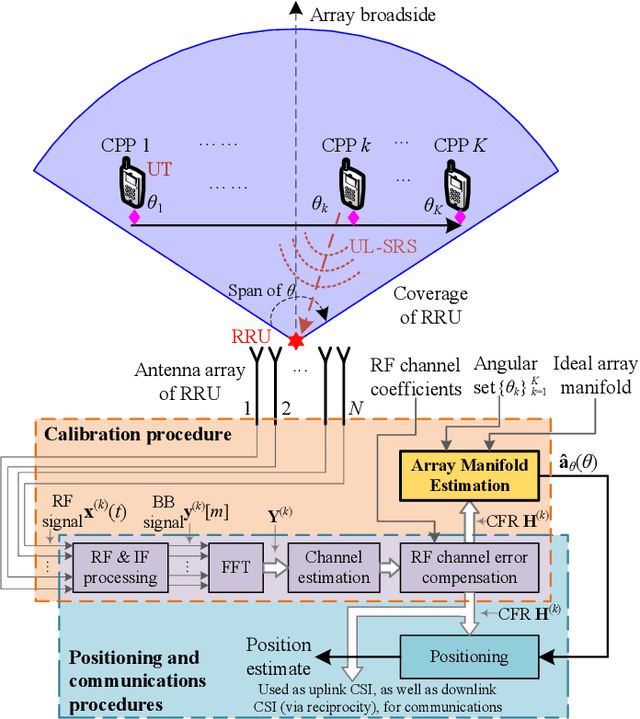
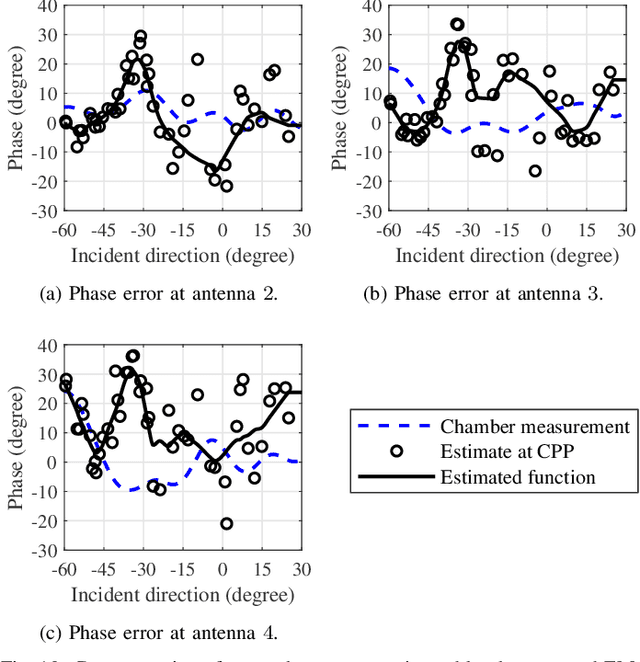
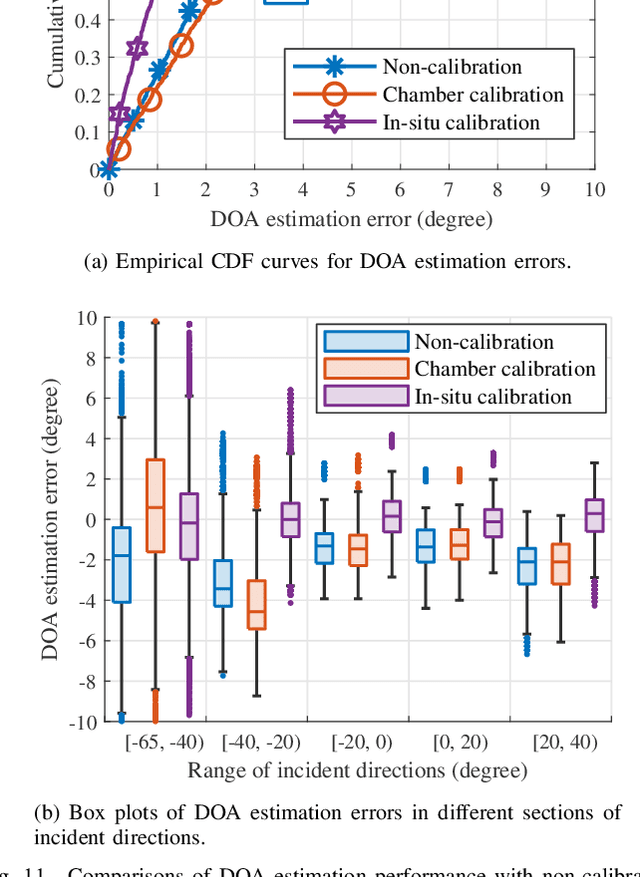
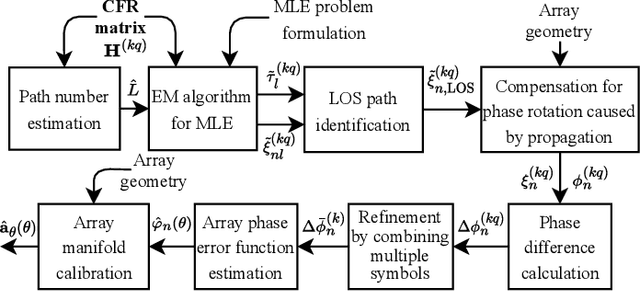
Abstract:Owing to the ubiquity of cellular communication signals, positioning with the fifth generation (5G) signal has emerged as a promising solution in global navigation satellite system-denied areas. Unfortunately, although the widely employed antenna arrays in 5G remote radio units (RRUs) facilitate the measurement of the direction of arrival (DOA), DOA-based positioning performance is severely degraded by array errors. This paper proposes an in-situ calibration framework with a user terminal transmitting 5G reference signals at several known positions in the actual operating environment and the accessible RRUs estimating their array errors from these reference signals. Further, since sub-6GHz small-cell RRUs deployed for indoor coverage generally have small-aperture antenna arrays, while 5G signals have plentiful bandwidth resources, this work segregates the multipath components via super-resolution delay estimation based on the maximum likelihood criteria. This differs significantly from existing in-situ calibration works which resolve multipaths in the spatial domain. The superiority of the proposed method is first verified by numerical simulations. We then demonstrate via field test with commercial 5G equipment that, a reduction of 46.7% for 1-${\sigma}$ DOA estimation error can be achieved by in-situ calibration using the proposed method.
Link-level simulator for 5G localization
Dec 26, 2022Abstract:Channel-state-information-based localization in 5G networks has been a promising way to obtain highly accurate positions compared to previous communication networks. However, there is no unified and effective platform to support the research on 5G localization algorithms. This paper releases a link-level simulator for 5G localization, which can depict realistic physical behaviors of the 5G positioning signal transmission. Specifically, we first develop a simulation architecture considering more elaborate parameter configuration and physical-layer processing. The architecture supports the link modeling at sub-6GHz and millimeter-wave (mmWave) frequency bands. Subsequently, the critical physical-layer components that determine the localization performance are designed and integrated. In particular, a lightweight new-radio channel model and hardware impairment functions that significantly limit the parameter estimation accuracy are developed. Finally, we present three application cases to evaluate the simulator, i.e. two-dimensional mobile terminal localization, mmWave beam sweeping, and beamforming-based angle estimation. The numerical results in the application cases present the performance diversity of localization algorithms in various impairment conditions.
Efficient Joint DOA and TOA Estimation for Indoor Positioning with 5G Picocell Base Stations
Jun 20, 2022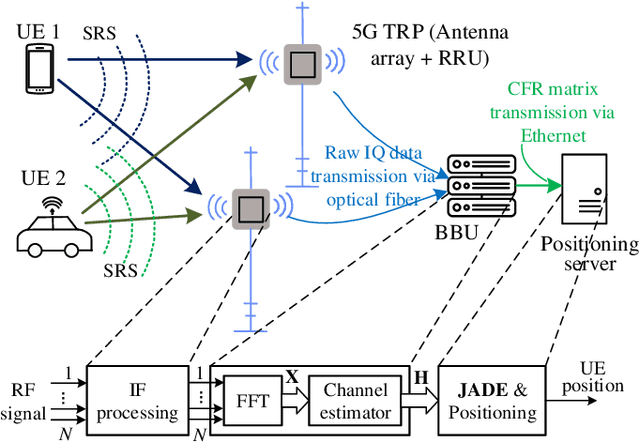
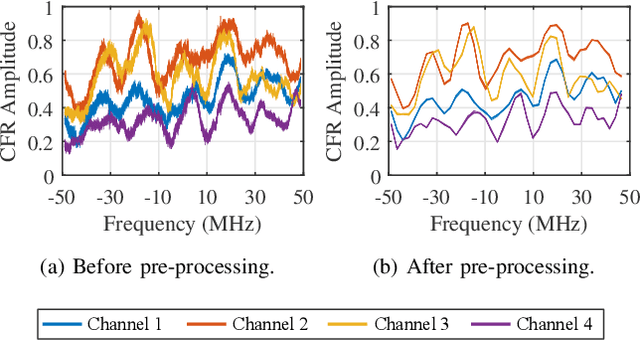
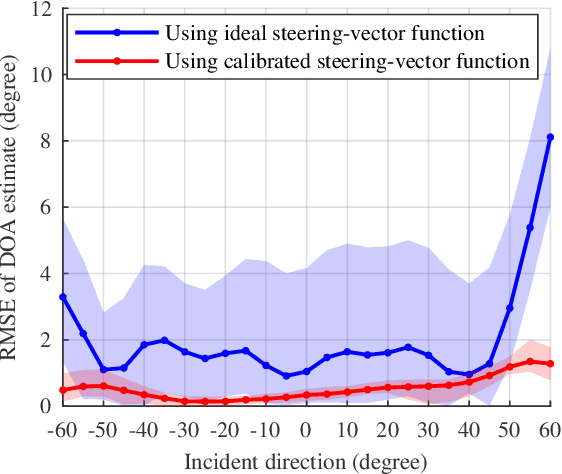
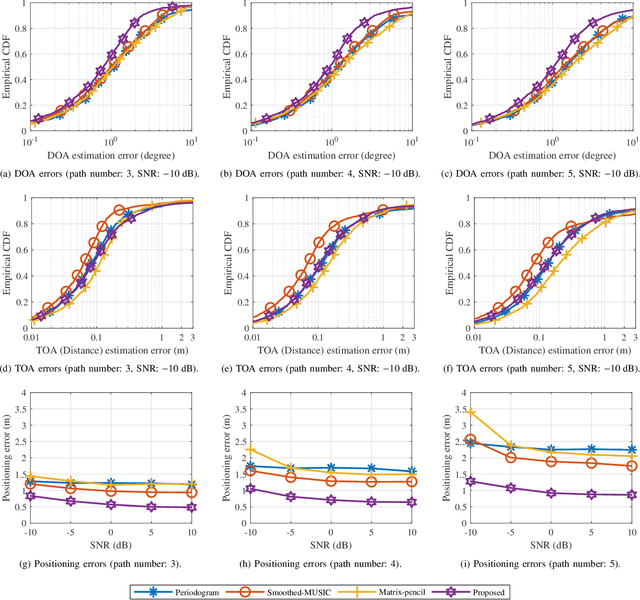
Abstract:The ubiquity, large bandwidth, and spatial diversity of the fifth generation (5G) cellular signal render it a promising candidate for accurate positioning in indoor environments where the global navigation satellite system (GNSS) signal is absent. In this paper, a joint angle and delay estimation (JADE) scheme is designed for 5G picocell base stations (gNBs) which addresses two crucial issues to make it both effective and efficient in realistic indoor environments. Firstly, the direction-dependence of the array modeling error for picocell gNB as well as its impact on JADE is revealed. This error is mitigated by fitting the array response measurements to a vector-valued function and pre-calibrating the ideal steering-vector with the fitted function. Secondly, based on the deployment reality that 5G picocell gNBs only have a small-scale antenna array but have a large signal bandwidth, the proposed scheme decouples the estimation of time-of-arrival (TOA) and direction-of-arrival (DOA) to reduce the huge complexity induced by two-dimensional joint processing. It employs the iterative-adaptive-approach (IAA) to resolve multipath signals in the TOA domain, followed by a conventional beamformer (CBF) to retrieve the desired line-of-sight DOA. By further exploiting a dimension-reducing pre-processing module and accelerating spectrum computing by fast Fourier transforms, an efficient implementation is achieved for real-time JADE. Numerical simulations demonstrate the superiority of the proposed method in terms of DOA estimation accuracy. Field tests show that a triangulation positioning error of 0.44 m is achieved for 90% cases using only DOAs estimated at two separated receiving points.
 Add to Chrome
Add to Chrome Add to Firefox
Add to Firefox Add to Edge
Add to Edge